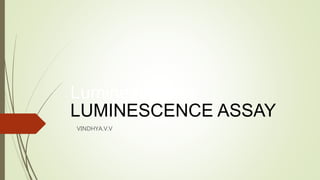Luminescence assay
•Download as PPTX, PDF•
4 likes•1,804 views
luminescence is the emission of light by substances as a result of some reactions.it is of 2 types flash and glow.based on reactions of substance luminescences are of different categories about 13 types described here,advantages,luminometer and nano BRET also explained.
Report
Share
Report
Share

Recommended
Recommended
More Related Content
What's hot
What's hot (20)
Immunoassay methods and their application in pharmaceutical analysis

Immunoassay methods and their application in pharmaceutical analysis
methods of extraction protein precipitation method.pptx

methods of extraction protein precipitation method.pptx
Principle and instrumentation of UV-visible spectrophotometer.

Principle and instrumentation of UV-visible spectrophotometer.
Similar to Luminescence assay
B.Sc. I Year Physical Chemistry_Unit-IV_A. Chemical Kinetics_Part II B.Sc. I Year Physical Chemistry_Unit-IV_A. Chemical Kinetics_Part II

B.Sc. I Year Physical Chemistry_Unit-IV_A. Chemical Kinetics_Part IIDepartment of Biochemistry, Veer Bahadur Singh Purvanchal Univarsity, Jaunpur
Similar to Luminescence assay (20)
Principles and application of fluorescence spectroscopy

Principles and application of fluorescence spectroscopy
B.Sc. I Year Physical Chemistry_Unit-IV_A. Chemical Kinetics_Part II

B.Sc. I Year Physical Chemistry_Unit-IV_A. Chemical Kinetics_Part II
Recently uploaded
Recently uploaded (20)
FAIRSpectra - Enabling the FAIRification of Spectroscopy and Spectrometry

FAIRSpectra - Enabling the FAIRification of Spectroscopy and Spectrometry
TransientOffsetin14CAftertheCarringtonEventRecordedbyPolarTreeRings

TransientOffsetin14CAftertheCarringtonEventRecordedbyPolarTreeRings
POGONATUM : morphology, anatomy, reproduction etc.

POGONATUM : morphology, anatomy, reproduction etc.
GBSN - Microbiology (Unit 3)Defense Mechanism of the body 

GBSN - Microbiology (Unit 3)Defense Mechanism of the body
Cyathodium bryophyte: morphology, anatomy, reproduction etc.

Cyathodium bryophyte: morphology, anatomy, reproduction etc.
Genetics and epigenetics of ADHD and comorbid conditions

Genetics and epigenetics of ADHD and comorbid conditions
Call Girls Ahmedabad +917728919243 call me Independent Escort Service

Call Girls Ahmedabad +917728919243 call me Independent Escort Service
Climate Change Impacts on Terrestrial and Aquatic Ecosystems.pptx

Climate Change Impacts on Terrestrial and Aquatic Ecosystems.pptx
Cot curve, melting temperature, unique and repetitive DNA

Cot curve, melting temperature, unique and repetitive DNA
LUNULARIA -features, morphology, anatomy ,reproduction etc.

LUNULARIA -features, morphology, anatomy ,reproduction etc.
development of diagnostic enzyme assay to detect leuser virus

development of diagnostic enzyme assay to detect leuser virus
Luminescence assay
- 2. Definition Luminescence is the emission of light by a substance as a result of a chemical reaction (chemiluminescence) or an enzymatic reaction (bioluminescence). The word luminescence is derived from the Latin word for light, lumen, and the Latin, escentia, meaning ‘the process of’ and hence is the process of giving off light
- 3. Luminescence can be divided into two types: Luminescence can be either a ‘flash(fluorescence,)or a ‘glow(’ phosphorescence) reaction, depending on the kinetic profiles. Flash luminescence gives a very bright signal for a short amount of time, usually seconds. Glow luminescence emits a more stable but usually less intense signal that can last for several minutes or hours. White microplates are usually recommended for luminescence as they reflect light and maximize the signal.
- 4. Types of luminescence The following are types of luminescence: Chemiluminescence, the emission of light as a result of a chemical reaction Bioluminescence, a result of biochemical reactions in a living organism Electrochemiluminescence, a result of an electrochemical reaction Lyoluminescence, a result of dissolving a solid (usually heavily irradiated) in a liquid solvent Candoluminescence, is light emitted by certain materials at elevated temperatures, which differs from the blackbody emission expected at the temperature in question. Crystalloluminescence, produced during crystallization Electroluminescence, a result of an electric current passed through a substance Cathodoluminescence, a result of a luminescent material being struck by electrons Mechanoluminescence, a result of a mechanical action on a solid
- 5. Photoluminescence, a result of absorption of photonsFluorescence, photoluminescence as a result of singlet–singlet electronic relaxation (typical lifetime: nanoseconds) Phosphorescence, photoluminescence as a result of triplet–singlet electronic relaxation Radioluminescence, a result of bombardment by ionizing radiation Thermoluminescence, the re-emission of absorbed energy when a substance is heated[5] Cryoluminescence, the emission of light when an object is cooled
- 6. Advantages of luminescence Luminescence is an extremely popular detection platform for many applications compared to absorbance and fluorescence higher sensitivity as background interference (autofluorescence from compounds, media and cells) is low. In addition, luminescence assays often use a homogenous (no wash) protocol, which makes them simpler to automate for high-throughput applications.
- 7. luminescence detection work luminescence is generated by a chemical or biological reaction, for example an enzyme and its substrate. The resulting light can be detected by a photomultiplier tube (PMT), in which photons are converted to electrons, with the resulting current proportional to the amount of light. Measurement of the signal is expressed as relative light units (RLU).
- 9. luminometer When a luminescence reaction is set up in a microplate, a luminometer (or luminescence microplate reader), is used to measure the amount of light produced. The microplate is placed in a light-tight read chamber, and light from each well is detected in turn by a PMT. The luminescence readings are expressed as RLU In most luminescence applications the total light produced by the sample is measured, without the selection of particular wavelengths. applications like BRET, a luminescence plate reader can be equipped with filters or monochromators that allow the selection of specific wavelengths in order to measure binding or other biomolecular events.
- 10. NanoBRET/BRET BRET (bioluminescence resonance energy transfer) is a technique for measuring protein-protein or protein-ligand interactions that involves the interaction of a bioluminescent donor and a fluorescent acceptor.
